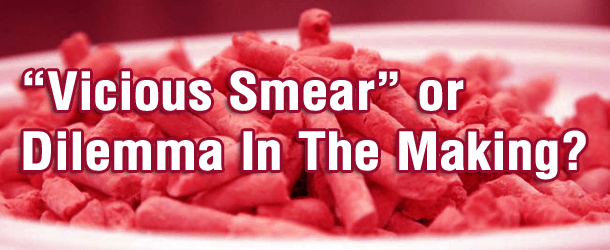
“Pink Slime” is certainly the hot topic of conversation these days. After the media controversy about it, several fast food chains, including McDonald’s, Taco Bell and Burger King, stopped using it. This sent the ground beef processing industry into a tailspin. AFA, one of the largest ground beef processors in the United States, just filed for bankruptcy protection. Iowa Governor, Terry Branstad, said the campaign against “pink slime” is a “vicious smear” by the food activists.
Is it really a vicious smear or is it a dilemma over what we feel is socially acceptable to eat?
Pink slime is the term for the sinew, bloody effluvia and bits of meat that are recovered from the carcass trimmings of cattle. These trimmings are then put into a spinning centrifuge, leaving a mash that is described as “pink slime”. The slime is then treated with ammonium hydroxide to kill pathogens and bacteria. It is frozen into small squares and sold as low cost “additive” to hamburger. Ten years ago, these “trimmings” were sold to pet food makers to be used as “additives” for pet food.
Although an additive, some argue that it greatly helps solve a serious food problem. The meat trimmings and additives other than pink slime that go into cheap hamburger are said to often be heavily contaminated with bacteria, some of them dangerous. Sometimes there has been found E. coli in cheap hamburger meat. The ammonia processing makes pink slime safe.
If public pressure causes pink slime to be eliminated, bacteria-laden beef trimmings will go back into hamburger, just as they used to, and the meat will be less safe. Is that what we want? Or, do we really want to eat parts of the cow that on their own would be inedible?
How much of a say do you want in the products you or your children consume? Even if pink slime is relatively safe and nutritious, it violates cultural norms to eat certain parts of animals.
This is true, especially when it is our children’s health at stake. Pink Slime was traced to school cafeterias where the pink slime regularly appears in USDA approved lunch meat. The Media outcry helped get parents to flood school districts with phone calls and online petitions to the USDA objecting to the use of pink slime. One of those petitions, by Bettina Siegel, mother and an attorney, stated that “it is simply wrong to feed our children connective tissues and beef scraps that were, in the past, destined for use in pet food and rendering, and were not considered fit for human consumption.”
Don’t our children deserve better? Of course they do! School lunches should be nutritious and full of food that we can identify and feel is culturally acceptable to eat.
The great news about pink slime is that public was able and empowered to determine the outcome of a product! This product wasn’t taken off the shelves because it was unsafe. On the contrary, the product was proven safe, and as some argue, safer than other alternatives. The real crux of the matter is that the public outcry changed the course of using pink slime so readily in our food products. The public “voice” was able to virtually eliminate use of a product that was determined unacceptable for society to consume. This is great news for the underdog, the consumer, who has shown that they can use their voice to improve products in the marketplace.
What product is next?
– Linda Ingham
As a mother of five, licensed attorney and fitness nut, Linda Ingham enjoys writing about many subjects, including law, gardening, health and fitness, child rearing and travel. Check out her articles at www.pathacross.com
Sources:
http://www.delish.com/food/recalls-reviews/pink-slime-controversy-news-timeline
http://www.huffingtonpost.com/bettina-elias-siegel/pink-slime-in-schools_b_1339237.html

